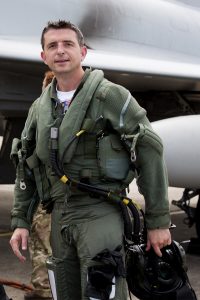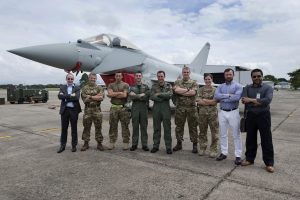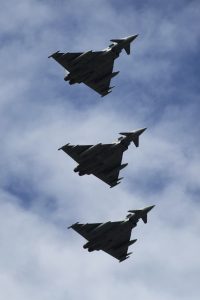2017-06-27 by Robbin Laird
During the past year, the Typhoons at RAF Lossiemouth have been deployed worldwide.
They have become mainstays at Operation Shader in the Middle East, and have been to the Pacific (South Korea, Malaysia and Japan) as well most recently to Red Flag and Green Flag in the United States.
As the Typhoon matures and is paired with the Voyager tanker/lifter, the expeditionary capabilities of the RAF have been clearly reinforced.
Also, since I was last at Lossie, the P-8 decision has been publically announced and the plans for rebuilding the base to accommodate UK and coalition P-8a have proceeded apace.
I had a chance to discuss these developments during a visit to RAF Lossiemouth during the week of March 19, 2017. In this interview, the Station Commander, Group Captain Paul Godfrey provided an overview on developments.
Question: It seems your Typhoon force has been quite busy recently; and with the addition of the Voyager even more capable of expeditionary operations.
How do you view recent developments in this regard?
Group Captain Godfrey: In my entire time in the Royal Air Force, I’ve not seen a global deployment as we managed at the end of last year with our deployment to Malaysia, Japan and Korea.
Throughout the period we visited the United Arab Emirates, India, Malaysia, Japan, The Republic of Korea, Brunei and back through India, UAE and Greece which is about as global a deployment as you can get.
 Image Shows: RAF Lossiemouth’s Station Commander, Group Captain Paul Godfrey returning from flying on Ex Bersama Lima 16. Credit: RAF
Image Shows: RAF Lossiemouth’s Station Commander, Group Captain Paul Godfrey returning from flying on Ex Bersama Lima 16. Credit: RAF
We were supported by C-17s and Voyagers from RAF Brize Norton which has made the RAF a truly expeditionary air force when you combine the advanced Typhoon with the Brize Norton global support capabilities.
I had the chance to fly onboard the Voyager on the way to Japan and watch them in their transport and refueling role. It is a very impressive aircraft. The Voyager supported us by moving personnel, and kit as well as air to air refueling between the various locations.
I sat next to the mission systems operator in the Voyager. I could see what amazing capabilities the aircraft has compared to VC10 and Tristar that I was used to a few years ago. The way they manage the fuel, the transfers and the fact that the fuel is carried internally, meaning they can still carry a large number of personnel and significant cargo inside the aircraft.
You’ve got a range of aircraft from the past rolled into one and you do not have to change out from air refueling to liftcombining the two into one platform.
It is capabilities like this that enabled the deployment – we just could not have done it without them.
Question: In many ways, this was an historic achievement for the RAF to move aircraft from Scotland to Japan and back again.
How do you assess this achievement?
Group Captain Godfrey: It was historic.
I knew this was a once in a lifetime event, but I didn’t really think about the ramifications, the size of what we had accomplished, until I returned to the UK; It was historic as this was the first time we’ve sent fighters to Japan.
The JASDF grasped the significance of this and were incredibly hospitable and welcoming throughout. Their two-star general Base Commander who greeted me on arrival had also been on Exchange in the USA flying the F-16 at the time I arrived on Exchange with the USAF at Luke AFB, so we had an immediate connection over our shared experience and the people we had both served with.
I flew a mission whilst in Japan and was incredibly impressed with the JASDF and everything they do.
We had common ground in terms of our experiences with Quick Reaction Alert.
From their bases they intercept Russian Blackjacks, the same aircraft we often intercept from Lossiemouth. It was interesting to listen to hear about their missions and to share experiences.
They were particularly interested in the scale of our deployment and how we had found Exercise BERSAMA LIMA in Malaysia.
The Japanese were impressed that with one or two C-17s, one or two Voyagers we were able to project power a long way from the United Kingdom.
The fact that the Royal Air Force received a letter of thanks from the Prime Minister of the UK once we had returned to home really did make us proud and demonstrate how our efforts had been appreciated by the Government as they look to strengthen Global relationships.
Question: You were flying from the base where the Japanese fly the F-2 as well as standing up their F-35s.
How did you find the base?
Group Captain Godfrey: It is a very well constructed airbase.
 Image Shows: RAF Lossiemouths Station Commander, Group Captain Paul Godfrey (third from left) and Officer Commanding 1(F) Sqn, Wing Commander Mike Sutton (forth from left) stood with personnel from 1(F) Sqn and Malaysian Press Journalists while taking part in Ex Bersama Lima 16. Credit: RAF
Image Shows: RAF Lossiemouths Station Commander, Group Captain Paul Godfrey (third from left) and Officer Commanding 1(F) Sqn, Wing Commander Mike Sutton (forth from left) stood with personnel from 1(F) Sqn and Malaysian Press Journalists while taking part in Ex Bersama Lima 16. Credit: RAF
We operated out of a modern hardened aircraft shelter site designed for the F2. Just behind it, the F-35 facilities were being built and the construction of those facilities is well advanced.
I do think that the links between the UK and Japan will be further strengthened by operating a common platform.
If we return to the Far East in the coming years we will have a natural interoperability that spans even languages; outside of F-35 capability, it really is a Global club that we are fortunate to be a part of.
Their F-2s are a very effective aircraft, which reflects as well the progress of their indigenous aerospace capabilities as well and how well they have partnered with the USA in order to bring the capability in.
Question: Let us shift to discussing the coming of the P-8s to Lossie.
When I was last here, the P-8s coming to Lossie was in process but now it has been publically announced.
How is the standup progressing from a base preparation point of view?
Group Captain Godfrey: It is a significant challenge to standup new infrastructure for the new Typhoon squadron and the P-8s squadrons.
We are focused on shaping an integrated approach, which can support the operations of the two aircraft in the future from this base.
To help us overcome the challenge, we have just had a Wing Commander assigned to Lossiemouth in order to head up the P-8 and Typhoon Transition Team and he will stand up a staff to work that part of the equation as well.
£400 million of investment is going into the base to enable the dual transition.
And we already have P-8s from the US Navy operating out of Lossie for the Joint Warrior exercises and our seedcorn officers in the United States are key players in the standup of our own P-8 capability.
 Image Shows: Three Typhoon Aircraft from 1(F) Sqn in the air while taking part in Ex Bersama Lima 16. Credit: RAF
Image Shows: Three Typhoon Aircraft from 1(F) Sqn in the air while taking part in Ex Bersama Lima 16. Credit: RAF
We have officers with significant flight time onboard the P-8 already at Jaxonville Navy With our first three pilots already achieving a thousand hours on the platform.
We will initially use the P-8 as a Maritime Patrol Aircraft but over time as we standup F-35 and P-8 we wills shape new approaches to ISR, C2 and strike.
We will clearly innovate in terms of using the P-8 and its capabilities to carry weapons, the ability to network with Link 16 and new nodes and then to integrate it with future capabilities of Typhoon and F-35s and with various unmanned vehicles.
These are exciting times for the RAF and at Lossie as well.
Question: When I was in Norway, obviously both the coming of the P-8 and the F-35 to the Norwegian Air Force opens up capabilities to collaborate with the RAF.
How do you view these prospects?
Group Captain Godfrey: When I flew to Estonia last year to visit the team on the NATO Baltic Air Policing Mission, I was over Norway quicker than it takes me to fly to our Typhoon base, RAF Coningsby, in England, so we’re very close neighbours.
We operate closely in terms of our air defense from the handover of Russian Long Range Aviation when they penetrate Norwegian airspace and then fly to ours.
There’s absolutely no reason that it we shouldn’t actively cooperate together in terms of maritime patrol especially when you’re operating the same airplane.
It would make sense that with common data links, and with mission data sharing to shape a common approach over the Northern European area of operations.
As I leave Lossiemouth in November this year, we’ll already be cutting turf to base P-8’s here. Given that we host Exercise Joint Warrior, I’ve seen the various maritime patrol aircraft from various nations operating together and it is great for us to be getting back into the Maritime Patrol role.
I’m clearly well aware of the capability of Typhoon and where Typhoon is going as well, and that in itself is exciting for the base and for the UK.
Whichever direction UK defense goes and whichever area of the world the strategy will prioritize whether it’s the North Atlantic, whether it’s the Middle East whether it’s elsewhere, Lossiemouth is going to be at the forefront just because of the capabilities that we have and will have here on the unit.
And don’t forget other capabilities as well such as our RAF Regiment. It is one of the few forces in the world that is specifically trained to be air minded for airfield defense operations.
Lossiemouth provides and will provide significant value for UK defense for many years to come.
Editor’s Note: For earlier updates from Group Captain Godfrey on RAF Lossiemouth during earlier visits to the base, see the following:
https://sldinfo.com/return-to-raf-lossiemouth-the-perspective-of-group-captain-paul-godfrey/
This is the first in a 8 part series built around interviews conducted at RAF Lossiemouth, March 2017.


